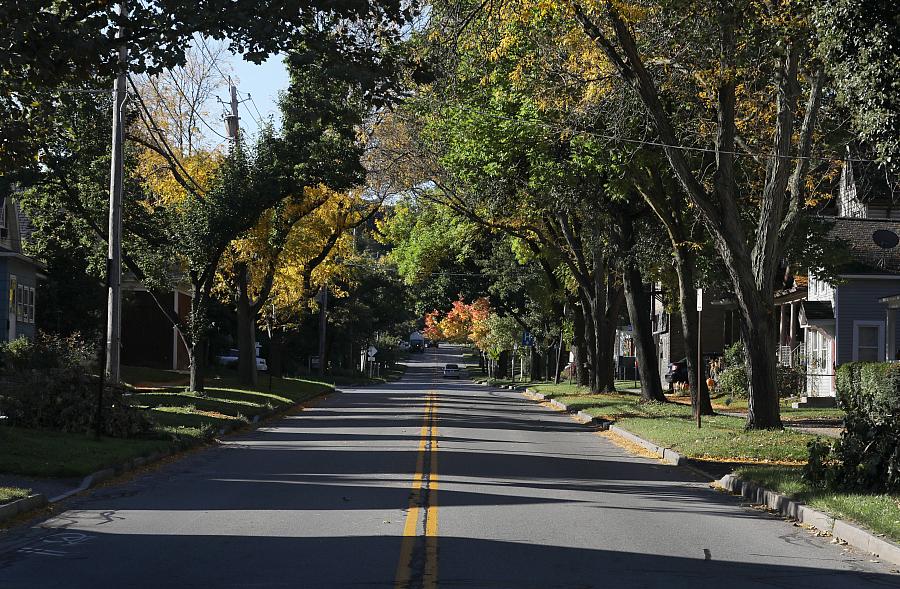Urban trees cool the air and save lives. Why aren’t there more of them?

A lush canopy of trees on South Goodman Street in Rochester, New York.
(Photo by Shawn Dowd/Democrat and Chronicle)
Children in Rochester, New York, had just been let out of school for the summer when the first significant heat wave arrived in late June 2021. For five days temperatures hovered in the high 80s and low 90s, combining with high humidity to make the first week of summer a sweltering one.
Those high temperatures were recorded at the Frederick Douglass Greater Rochester International Airport and serve as shorthand for the region. The reality, though, is more complicated.
An aerial view of the city of Rochester shows the southeast quadrant to be blanketed in green. That is due in part to large parks but also to a generous tree canopy. In these neighborhoods, the residents are mostly white, the houses are single-family and home values reflect the attractiveness of the tree cover.
On some privileged streets, hundred-year-old maples and oaks arch entirely over the roadway, making it possible to walk several blocks at a stretch in the cool shade. The heat is mediated by the shade. It is warm, to be sure, but there is some respite.
Across town the experience on a hot June day is much different. Trees are less mature, if they exist at all. The sun blasts the pavement, generating ambient heat and making the sidewalk feel like a toaster oven. Residents here are mostly not white, and mostly do not own the houses and apartments where they live. Hot days are just that – hot.
The effect of this difference goes beyond temporary discomfort. A vast body of research shows major benefits for people living near trees or significant greenery, in particular in urban settings.
Perhaps the fundamental difference is in air temperature and quality. Trees not only create shade but prevent heat from building up in and radiating out from sidewalks. Some studies have found differences of five degrees Fahrenheit or more from street trees alone; urban parks, even small ones, have a greater effect.
At the same time, trees filter out pollutants from the air; each individual tree has a demonstrable effect on air quality in its immediate surroundings, and the benefit is amplified with the number of trees planted.
Those air temperature and quality effects in turn have been shown to improve the health of people living around them. Lower temperatures and cleaner air can prevent respiratory illness, including asthma. Studies also demonstrate a link between access to trees and improved mental health.
If trees can do so much good, why aren’t they planted equally throughout the city? The answer, as with so many societal ills, goes back to discriminatory and racist actions by the government and private actors throughout the 20th century as Rochester and Monroe County were being built.
Parks were placed in comparatively wealthy sections of the city, as were lush thoroughfares like Seneca Parkway in Maplewood and Nunda Boulevard in the Cobbs Hill neighborhood. Often, these green parcels were donated and maintained by private developers.
The blossoming magnolia trees on Oxford Street, for example, date back to the late 19th century, when the street was part of Henry Hooker’s farm. He developed part of it for housing and laid the magnolias out himself. The city and local volunteers have maintained them ever since.
By contrast, housing built for European immigrants and southern Black migrants in the early- to mid-20th century was conceived in strictly economic terms, with no serious consideration for green space.
One critic in the early 1970s, for example, described Rochester’s first public housing project, the Hanover Houses, as illustrating “an approach which implies that housing for low income families must be esthetic wastelands, so as not to offend ‘the silent majority taxpayer.’”
Climate change has added even greater urgency to address inequity in the urban forest. Pulling carbon dioxide out of the atmosphere and making cities more livable are crucial steps to making a cooler, more resilient planet.
Yet the answer is not as simple as dropping seeds in the ground and walking away. For some people, trees are a nuisance and a hazard. They add pollen to the air, drop leaves in the fall and can provide cover for unsavory activities. Eventually they die, sometimes taking a chunk of roof with them.
My reporting on the urban forest in Rochester under the auspices of the 2021 Data Fellowship, then, will include three main strands. One is data on tree distribution and effects on air quality and human health. The second is the historical context of how trees came to be where they are, and why. The third is what ties it together: gathering the voices of Rochester residents to explain how they are affected by the trees that stand, or do not stand, in their communities.
Together, those three elements provide an important insight into the inequitable way that our community was built. At the same time, they hopefully will offer a roadmap toward a more just and sustainable future.

